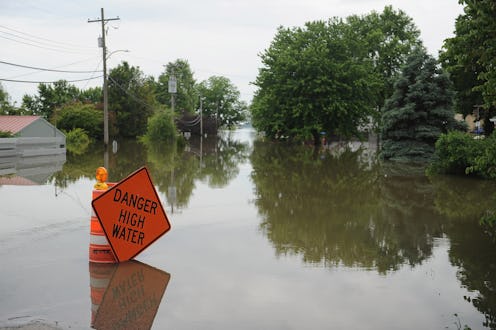Life
Floods Can Be The Deadliest Part Of Storms — Here Are 5 Important Steps To Prepare

Fall officially begins Sept. 23, but we can't say goodbye to bad storms just yet as multiple weather systems threaten parts of the U.S., Mexico, and the Caribbean. Even once hurricane season ends in November, flooding is a year-round concern. You don't want to wait until you're actually under a flood watch or warning to think about a flood preparedness checklist — there are a few key steps you should take ahead of time.
It makes sense to be afraid of wind when bracing for a serious storm, but nearly 90% of hurricane deaths happen because of water, according to The Weather Channel. And since floods can develop within hours, per the National Weather Service, you can't count on having days or weeks to prepare. Flooding can have devastating consequences as well: Tropical Depression Imelda has caused flooding so severe that Texas governor Greg Abbott declared a state of emergency in 13 counties, and parts of southwestern Mexico are at risk for flash flooding due to Tropical Storm Lorena.
Even if there aren't any current flood threats in your area, you can start preparing for the worst-case scenario. If you live in an area that's flood-prone, here's what you should do to get ready for inclement weather.
Learn About Flood Risk
FEMA offers a Flood Map Service Center to find out whether you're in a high-risk area for floods. Even if you don't live in an area that's usually susceptible to flooding, you should check your homeowners insurance — FEMA says that most policies don't cover flood damage, and it isn't cheap if you're paying for it yourself. According to the agency, one inch of flooding in an average-sized home can cause nearly $27,000 in damages.
Know Where You'd Evacuate
Research your county and city's emergency management plans, and find out which shelters are closest to you. If you do need to evacuate, knowing where to go ahead of time is important. FEMA and state governments offer funding for people who want to build stormproof "safe rooms" in their homes, which is one way to increase your chances of staying safe during a storm.
Research Safe Driving During Floods
According to Ready.gov, a government website dedicated to disaster and emergency planning, you shouldn't ever drive around barricades during a flood. Even if a road doesn't look flooded, it can be dangerous. You should also avoid bridges if they're over fast-moving water — 53 people have died in 2019 from driving in floods, per the National Weather Service.
Create An Emergency Kit
Because floods move quickly, it's a good idea to have a bag ready with necessary supplies. You'll also be able to avoid crowded grocery stores with near-empty shelves if you prepare beforehand. Here are some FEMA emergency kit recommendations:
- Water
- Non-perishable food
- A battery-powered radio
- A flashlight
- A first aid kit
- Batteries
- Maps
- Phone chargers
Figure Out Where You'd Put Valuables
You won't be able to take everything with you when you're fleeing a flood, and moving your valuables and furniture to the highest part of your home can help you protect them. The Red Cross says that you should only do this if you have time because your safety is the top priority.
Floods are terrifying, and there isn't anything you can do to prevent one from hitting you — but by preparing ahead of time, you'll feel more ready if you get news that bad weather is heading your way.
This article was originally published on